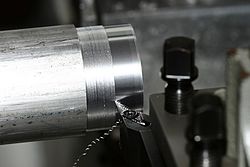Friction Stir Weld
Größe:
3504 x 2336 Pixel (986437 Bytes)
Beschreibung:
This close-up view of the friction stir weld tack tool used to manufacture of
space shuttle external tanks shows the process of tack welding barrel panels together. Barrels were previously fabricated using traditional fusion welding, but
friction stir welding is different in that the materials are not melted. A rotating tool pin uses friction and applied pressure to join the 20-foot longitudinal panels together. Friction stir welding is the most recent upgrade to the space shuttle's external tank, the largest element of the shuttle and the only element that is not reusable. The new welding technique utilizes frictional heating combined with forging
pressure to produce high-strength bonds virtually free of defects. Friction stir welding transforms the
metals from a solid state into a "plastic-like" state, and then mechanically stirs the materials together under pressure to form a welded joint. Invented and patented by
The Welding Institute, a
British research and technology organization, the process is applicable to
aerospace,
shipbuilding,
aircraft and
automotive industries. One of the key benefits of this new
technology is that it allows welds to be made on
aluminium alloys that cannot be readily fusion arc welded, the traditional method of welding.
Weitere Informationen zur Lizenz des Bildes finden Sie hier. Letzte Aktualisierung: Sun, 05 Feb 2023 18:09:01 GMT
Relevante Bilder
Relevante Artikel
Reibschweißen
Das Reibschweißen ist ein Schweißverfahren aus der Gruppe des Pressschweißens. Dabei werden zwei Teile unter Druck relativ zueinander bewegt, wobei sich die Teile an den Kontaktflächen berühren. Durch die entstehende Reibung kommt es zur Erwärmung und Plastifizierung des Materials. Am Ende des Reibvorganges ist es von entscheidender Bedeutung, die Teile richtig zueinander zu positionieren und einen hohen Druck auszuüben. Die Vorteile dieses Verfahrens sind, dass die sogenannte Wärmeeinflusszone deutlich kleiner ist als bei anderen Schweißverfahren und dass es nicht zur Bildung von Schmelze in der Fügezone kommt. Es entsteht ein sehr feinkörniges Gefüge mit sehr guten Festigkeitseigenschaften der Verbindungsstelle. Es können eine Vielzahl von Werkstoffen, wie beispielsweise Aluminium mit Stahl, miteinander verschweißt werden. Auch die Verbindung von metallischen Werkstoffen, die keine Legierungen miteinander eingehen, ist vielfach möglich.
.. weiterlesen







